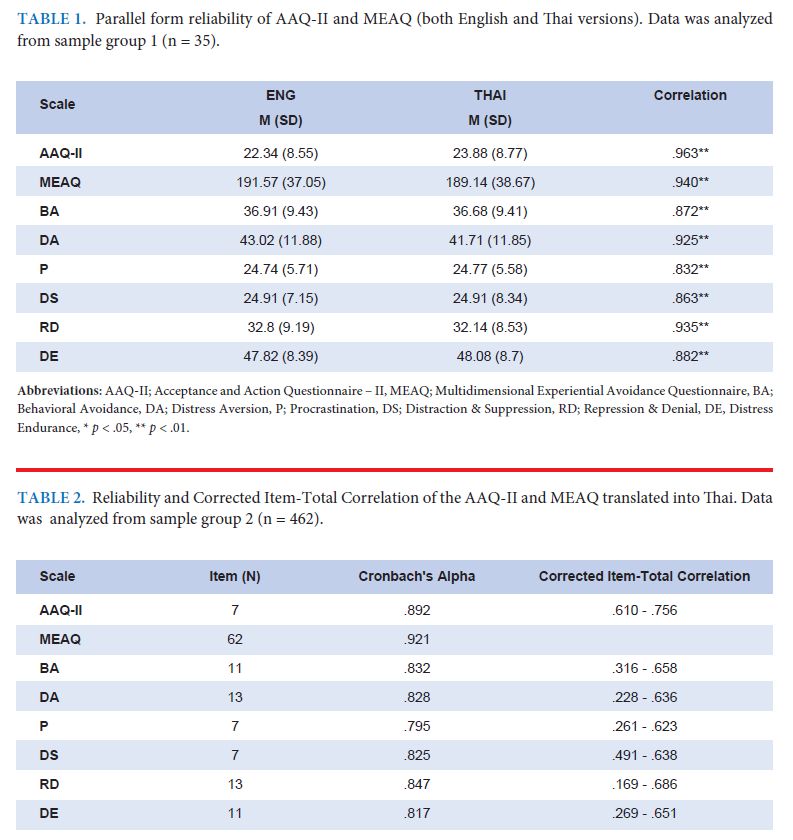Psychometric Properties of Scales for Assessing Experiential Avoidance
DOI:
https://doi.org/10.33192/Smj.2022.90Keywords:
Acceptance and Action Questionnaire – II (AAQ-II), ultidimensional Experiential Avoidance Questionnaire (MEAQ), Psychometric PropertiesAbstract
Objective: To study and compare the psychometric properties, reliability, and validity of the Acceptance and Action Questionnaire (AAQ-II) and the Multidimensional Experiential Avoidance Questionnaire (MEAQ), which were translated into Thai.
Materials and Methods: This study used the AAQ-II and MEAQ, which were back translated into Thai. The Depression Anxiety Stress Scale 21 (DASS-21) and Satisfaction with Life Scale (SWLS) were used in conjunction to collect data from 35 graduate students (females 77.1%) and 462 people from the general population of Bangkok (females 74.2%).
Result: Item Objective Congruence (IOC) of AAQ-II and MEAQ was 0.79 and 0.87, respectively. Both had high correlation coefficients with DASS-21 and SWLS, indicating criteria-related validity. Moreover, Confirmatory Factor Analysis (CFA) was also carried out. The correlation coefficient to the original was high (0.96 for AAQ-II and MEAQ, and subscales ranging from 0.83-0.94). They also had high internal consistency, with Cronbach’s alpha being 0.89 in AAQ-II and 0.92 in MEAQ, with high construct reliability (0.88 and 0.79-0.86).
Conclusion: The translated versions of AAQ-II and MEAQ have good psychometric properties. When comparing AAQ-II with MEAQ, it was noted that the correlation between AAQ and other scales was higher than MEAQ, which only had a moderate correlation. AAQ-II also tends to have a high association with distress variables. However, it is still possible to assess experiential avoidance. Thus, the use of each questionnaire will be depended on certain objectives.
References
Hayes SC, Strosahl KD, Wilson KG. Acceptance and commitment therapy: An experiential approach to behavior change. New York: Guilford Press; 1999.
Hayes SC, Wilson KG. Acceptance and commitment therapy: Altering the verbal support for experiential avoidance. Behav Anal. 1994;17(2):289-303.
Hayes SC, Wilson KG, Gifford EV, Follette VM, Strosahl K. Experimental avoidance and behavioral disorders: a functional dimensional approach to diagnosis and treatment. J Consult Clin Psychol. 1996;64(6):1152-68.
Kashdan TB, Barrios V, Forsyth JP, Steger MF. Experiential avoidance as a generalized psychological vulnerability: comparisons with coping and emotion regulation strategies. Behav Res Ther. 2006;44(9):1301-20.
Stewart SH, Zvolensky MJ, Eifert GH. The relations of anxiety sensitivity, experiential avoidance, and alexithymic coping to young adults' motivations for drinking. Behav Modif. 2002;26(2):274-96.
Westrup D. Experiential avoidance and alcohol dependence relapse (Doctoral Dissertation, West Virginia University, 1999). Dissertation Abstracts International. 1999;62:568.
Shorey RC, Gawrysiak MJ, Elmquist J, Brem M, Anderson S, Stuart GL. Experiential avoidance, distress tolerance, and substance use cravings among adults in residential treatment for substance use disorders. J Addict Dis. 2017;36(3):151-7.
Kashdan TB, Morina N, Priebe S. Post-traumatic stress disorder, social anxiety disorder, and depression in survivors of the Kosovo War: experiential avoidance as a contributor to distress and quality of life. J Anxiety Disord. 2009;23(2):185-96.
Spendelow JS, Joubert HE. Does Experiential Avoidance Mediate the Relationship Between Gender Role Conflict and Psychological Distress? Am J Mens Health. 2017:1557988317748123.
Hayes SC, Barnes-Holmes D, Roche B. Relational frame theory: a post-Skinnerian account of human language and cognition. Adv Child Dev Behav. 2001;28:101-38.
Bond FW, Hayes SC, Baer RA, Carpenter KM, Guenole N, Orcutt HK, et al. Preliminary psychometric properties of the Acceptance and Action Questionnaire-II: a revised measure of psychological inflexibility and experiential avoidance. Behav Ther. 2011;42(4):676-88.
Gamez W, Chmielewski M, Kotov R, Ruggero C, Watson D. Development of a measure of experiential avoidance: the Multidimensional Experiential Avoidance Questionnaire. Psychol Assess. 2011;23(3):692-713.
Silpakit O, Silpakit C. The Psychometric Property of the Short Thai Version of the Philadelphia Mindfulness Scale. Siriraj Med J. 2018;70(4):310-26.
Oei TP, Sawang S, Goh YW, Mukhtar F. Using the Depression Anxiety Stress Scale 21 (DASS-21) across cultures. Int J Psychol. 2013;48(6):1018-29.
Diener E, Emmons RA, Larsen RJ, Griffin S. The Satisfaction with Life Scale. J Pers Assess. 1985;49(1):71-5.
Sawasdipanich N, Tiansawad S. Instrument Translation for Cross-Cultural Research: Technique and Issues to be Considered. Thai Journal of Nursing Counsil. 2011;26(1):19-28.
Choochom O. Construction and Development of Measuring Instruments in Behavioral Science. Srinarkharinwirot University. Behavioral Science Research Institute; 2002.
Streiner DL, Norman GR, Cairney J. Health Measurement Scales: A practical guide to their development and use: Oxford University Press; 2014.
Ruiz FJ, Langer Herrera AI, Luciano C, Cangas AJ, Beltran I. Measuring experiential avoidance and psychological inflexibility: The Spanish version of the Acceptance and Action Questionnaire - II. Psicothema. 2013;25(1):123-9.
Joseph F. Hair, William C. Black, Babin BJ. Multivariate Data Analysis: A Global Perspective. 7th ed. Upper Saddle River: Pearson Education; 2010.
Fornell C, Larcker DF. Evaluating structural equation models with unobservable variables and measurement error. Journal of Marketing Research. 1981;18(1):39-50.
Stevens JP. Applied multivariate statistics for the social sciences, 5th ed. New York, NY, US: Routledge/Taylor & Francis Group; 2009. xii, 651-xii, p.
Rochefort C, Baldwin AS, Chmielewski M. Experiential Avoidance: An Examination of the Construct Validity of the AAQ-II and MEAQ. Behav Ther. 2018;49(3):435-49.
Wolgast M. What Does the Acceptance and Action Questionnaire (AAQ-II) Really Measure? Behav Ther. 2014;45(6):831-9.

Published
How to Cite
Issue
Section
License

This work is licensed under a Creative Commons Attribution-NonCommercial-NoDerivatives 4.0 International License.
Authors who publish with this journal agree to the following conditions:
Copyright Transfer
In submitting a manuscript, the authors acknowledge that the work will become the copyrighted property of Siriraj Medical Journal upon publication.
License
Articles are licensed under a Creative Commons Attribution-NonCommercial-NoDerivatives 4.0 International License (CC BY-NC-ND 4.0). This license allows for the sharing of the work for non-commercial purposes with proper attribution to the authors and the journal. However, it does not permit modifications or the creation of derivative works.
Sharing and Access
Authors are encouraged to share their article on their personal or institutional websites and through other non-commercial platforms. Doing so can increase readership and citations.














